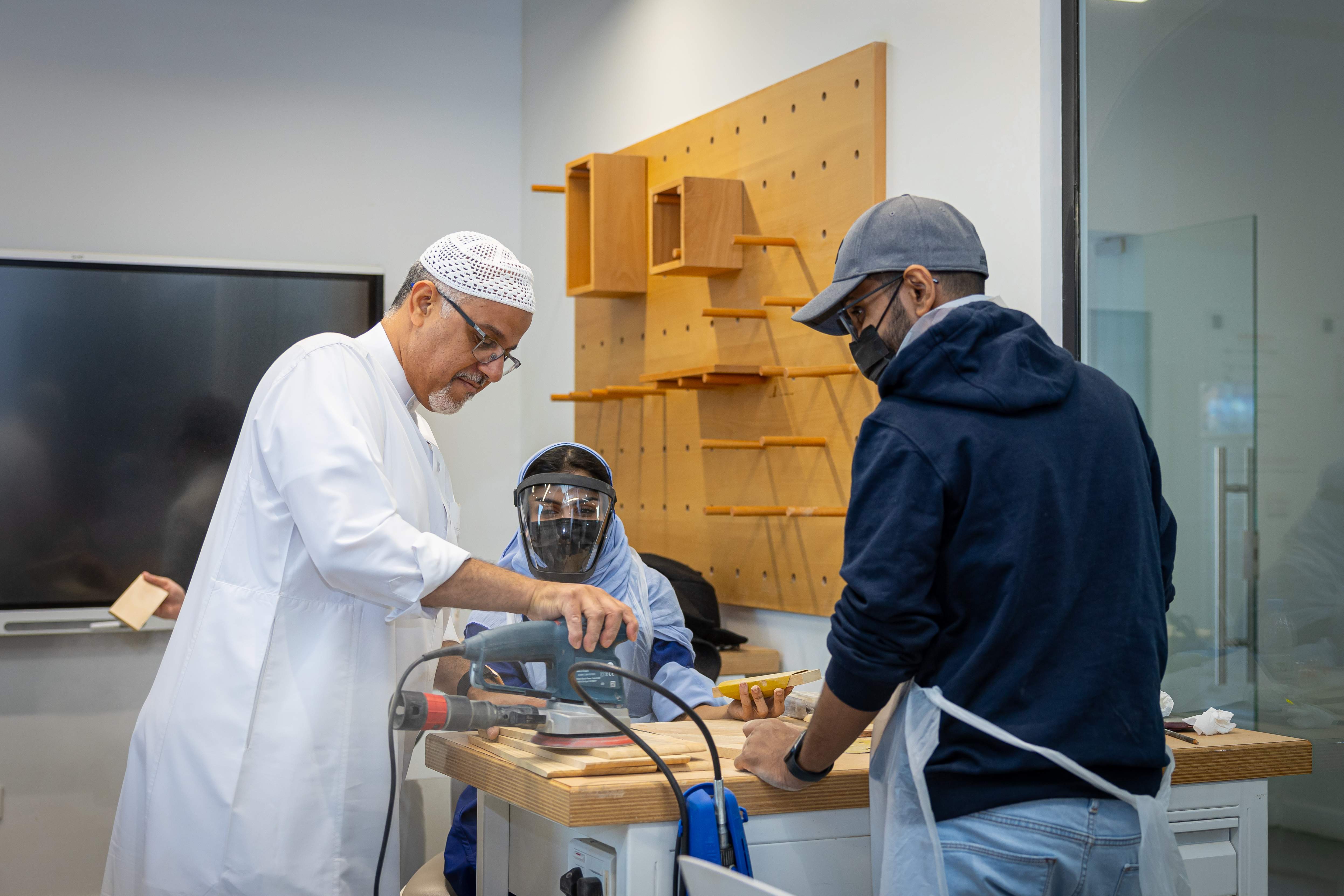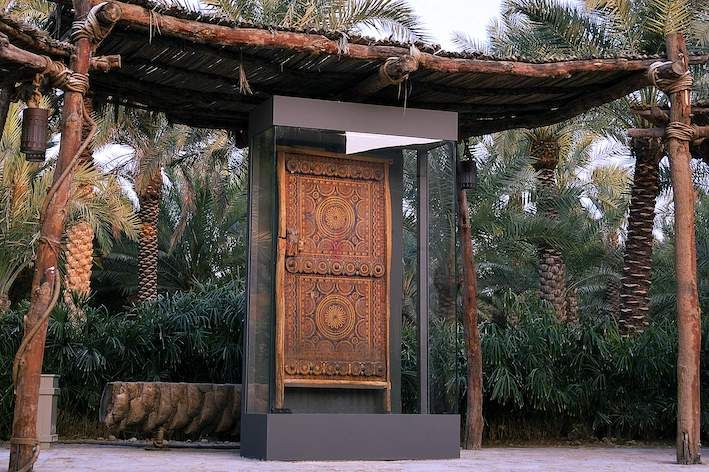Stories Eternalized by doors
Najdi doors in the village of Ushaiger, courtesy of the Royal Institute of Traditional Arts (Wrth).
The role of architecture in Saudi Arabia was not limited to utilitarianism only but extended to the aesthetic aspect. The craft of making traditional doors represented an important part of our heritage that was passed down from one generation to the other. These doors began to tell and immortalize stories about the diversity that our country witnessed - and continues to witness - in terms of society, the nature surrounding its raw materials, and the visual details that distinguished the doors across regions.
The Royal Institute of Traditional Arts (Wrth) takes great aims to preserve the rich and unique cultural heritage found in all this. The institute represents the culture of the Kingdom by narrating the artistic history, sharing the stories of traditional artworks, and highlighting the artists. Additionally, it strives to preserve the authenticity of these arts, and encourage those interested to learn, master and develop them. We had a wonderful conversation with Dr. Suzan Alyahya, head of Wrth, about one of their initiatives that is concerned with the techniques and methods of making traditional doors.

CEO of the Royal Institute of Traditional Arts (WRTH), Dr. Suzan bint Mohammed Al Yahya.
The discussion started with the importance of carpentry in the Kingdom, specifically in the field of traditional door making. Dr. Alyahya asserted: “The carpentry craft is one of the traditional crafts deeply rooted in Saudi culture, and it has an important position that cannot be overlooked. That is why we seek, through part of our initiatives at the Royal Institute, to preserve it as an inexhaustible heritage asset. This is done by enhancing awareness of the cultural importance of carpentry, and all related industries such as the art of carpentry, traditional wooden doors, incense burners, and other woodwork.
This awareness will train and refine the skills of practitioners of the craft, drive awareness to those interested in it, and may even extend to discovering new talents working in the field and developing their skills.
“As for traditional doors, they were and still are a witness to the diverse cultural fabric of the Kingdom, as each door represents the geographical identity of the place, the social identity of residents, their general taste, and their values of generosity and hospitality. Not only that, but the importance of these doors, with their decorative and aesthetic details, extends to reflecting the artistic and technical development of carpentry in general, and the manufacture of traditional doors in particular.”

Najdi Door in Ushaiger Village, courtesy of the Royal Institute of Traditional Arts (Wrth).
Referring to traditional doors, their beginnings and development, Dr. Alyahya noted: “The craft of making traditional doors, like everything known to humanity, has developed in response to different human needs. We notice that the materials used in the industry have changed and have been replaced by more durable materials such as wood and stone. Other details have been added that human needs called for, such as adding locks made of metal to provide protection and create a sense of security and reassurance. The matter was not limited to the development and change of the raw materials used in the industry but extended to include the difference in doors and their purpose.
“For example, there is a door called (Kamr), which is a small door that is adjacent to the place where the fire is lit, and behind it are usually the hospitality tools in the council.
There is also a (Darwaza) door, which is distinguished by its large size, so it is used at the entrances to cities and their walls, or in large buildings with a wide courtyard. There is also the (Dar/Street) door, which is the main and external door of the house, and its legs were made from palm trunks. These traditional doors throughout their development journey were not silent but were distinguished by colorful geometric and plant decorations and engravings, and the most beautiful thing is that these doors were the product of their environment, so the colors used were extracted from the natural components surrounding them.”

Najdi Door on Ushaiger Village, courtesy of the Royal Institute of Traditional Arts (Wrth).
When asked about the difference in traditional door making from one region to another, Dr. Alyahya replied: “The world of traditional door making in the Kingdom symbolizes bright beginnings and carries within it many ancient tales. It is also a witness to the bounty of our land, from which we draw inspiration in everything related to values, beauty, and art. Because the craftsman is a child of his environment and land, we see a clear difference in the level of wood types used. For example, we see tamarisk wood and palm trunks in Najdi doors in the Central Region, and we see teak wood in the Eastern Region, juniper wood in the Southern Region, and Saj wood in the Western Region. As I mentioned earlier, this difference extends to the type of decoration used in each region, according to what resembles its nature.”

From the Najdi Door Making Apprenticeship Program, courtesy of the Royal Institute of Traditional Arts (Wrth).
On Wrth’s initiatives to support the traditional door industry, Dr. Alyahya stated:
“Wrth is a destination for anyone passionate about traditional Saudi arts, a passion which we have carried with us since the founding day, and a passion which we will carry into the future. The essence of our vision is to empower the traditional arts sector in the Kingdom by providing quality educational, cultural and community programs, and stimulating documentation, research and innovation for a sustainable and vibrant market. Our strategy at Wrth is to support and encourage enthusiasts and creators by opening doors of opportunities for them between training and development, display and celebration, and support and empowerment. As for traditional doors, we at Wrth have launched several programs ranging from education for anyone interested, to apprenticeship programs with continuous training for those who wish to reach the level of mastery, or let’s say professionalism.

Najdi Door Making Apprenticeship Program, courtesy of the Royal Institute of Traditional Arts (Wrth).
“One of these programs that we launched was the Najdi Doors Industry Apprenticeship Program in Al Qassim Region, which was presented by experienced craftsmen, and through which they addressed the basics of carpentry, traditional Najdi door manufacturing techniques and decoration, and practical training in manufacturing wooden doors inspired by Najd’s heritage. This training was done through three levels. The first level includes learning the craft in its authentic traditional form, understanding the historical context, and using tools safely. The second level focuses on developing advanced and innovative craft skills. Finally, the third level focuses on entrepreneurial and professional empowerment of the craft and preparing learners for the labor market.”


